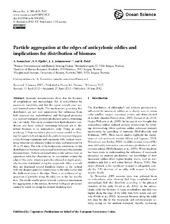| dc.contributor.author | Samuelsen, Annette | |
| dc.contributor.author | Hjøllo, Solfrid Sætre | |
| dc.contributor.author | Johannessen, Johnny Andre | |
| dc.contributor.author | Patel, Ruben | |
| dc.date.accessioned | 2018-08-01T07:54:39Z | |
| dc.date.available | 2018-08-01T07:54:39Z | |
| dc.date.issued | 2012-06-14 | |
| dc.Published | Samuelsen A, Hjøllo SS, Johannessen JA, Patel R. Particle aggregation at the edges of anticyclonic eddies and implications for distribution of biomass. Ocean Science. 2012;8(3):389-400 | eng |
| dc.identifier.issn | 1812-0792 | en_US |
| dc.identifier.issn | 1812-0784 | en_US |
| dc.identifier.uri | https://hdl.handle.net/1956/17936 | |
| dc.description.abstract | Acoustic measurements show that the biomass of zooplankton and mesopelagic fish is redistributed by mesoscale variability and that the signal extends over several hundred meters depth. The mechanisms governing this distribution are not well understood, but influences from both physical (i.e. redistribution) and biological processes (i.e. nutrient transport, primary production, active swimming, etc.) are likely. This study examines how hydrodynamic conditions and basic vertical swimming behavior act to distribute biomass in an anticyclonic eddy. Using an eddy-resolving 2.3 km-resolution physical ocean model as forcing for a particle-tracking module, particles representing passively floating organisms and organisms with vertical swimming behavior are released within an eddy and monitored for 20 to 30 days. The role of hydrodynamic conditions on the distribution of biomass is discussed in relation to the acoustic measurements. Particles released close to the surface tend, in agreement with the observations, to accumulate around the edge of the eddy, whereas particles released at depth gradually become distributed along the isopycnals. After a month they are displaced several hundreds meters in the vertical with the deepest particles found close to the eddy center and the shallowest close to the edge. There is no evidence of aggregation of particles along the eddy rim in the last simulation. The model results points towards a physical mechanism for aggregation at the surface, however biological processes cannot be ruled out using the current modeling tool. | en_US |
| dc.language.iso | eng | eng |
| dc.publisher | Copernicus Publications | en_US |
| dc.rights | Attribution CC BY | eng |
| dc.rights.uri | http://creativecommons.org/licenses/by/3.0/ | eng |
| dc.title | Particle aggregation at the edges of anticyclonic eddies and implications for distribution of biomass | en_US |
| dc.type | Peer reviewed | |
| dc.type | Journal article | |
| dc.date.updated | 2018-03-22T11:32:43Z | |
| dc.description.version | publishedVersion | en_US |
| dc.rights.holder | Copyright 2012 The Author(s) | en_US |
| dc.identifier.doi | https://doi.org/10.5194/os-8-389-2012 | |
| dc.identifier.cristin | 935114 | |
| dc.source.journal | Ocean Science | |
| dc.relation.project | Notur/NorStore: nn2993k | |
| dc.relation.project | Norges forskningsråd: 190261 | |
| dc.subject.nsi | VDP::Teknologi: 500::Informasjons- og kommunikasjonsteknologi: 550::Geografiske informasjonssystemer: 555 | |
| dc.subject.nsi | VDP::Technology: 500::Information and communication technology: 550::Geographic information systems: 555 | |
| dc.subject.nsi | VDP::Matematikk og naturvitenskap: 400::Geofag: 450::Oseanografi: 452 | |
| dc.subject.nsi | VDP::Mathematics and natural scienses: 400::Geosciences: 450::Oceanography: 452 | |

